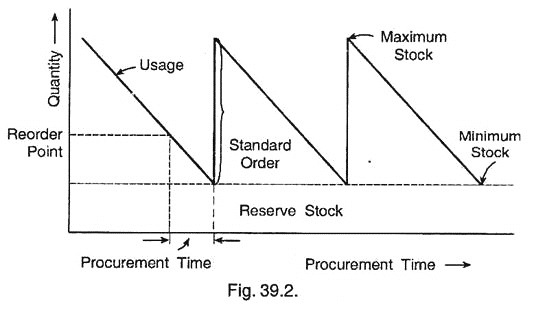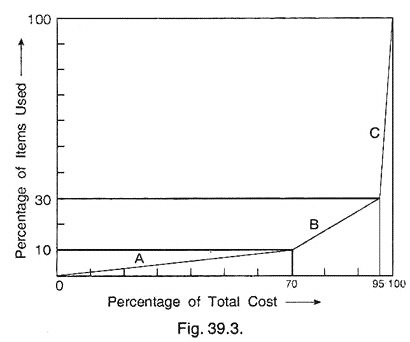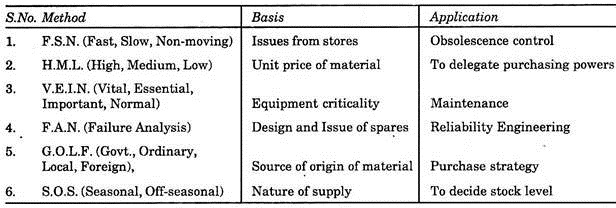After reading this essay you will learn about:- 1. Meaning and Need for Inventory Control 2. Classification of Inventories 3. Functions of Inventory Control 4. Quantity Standards as a Tool 5. Selective Techniques.
Contents:
- Essay on the Meaning and Need for Inventory Control
- Essay on the Classification of Inventories
- Essay on the Functions of Inventory Control
- Essay on the Quantity Standards as a Tool for Inventory Control
- Essay on the Selective Techniques for Inventory Control
Essay # 1. Meaning and Need for Inventory Control:
It may be defined “as the systematic location storage and recording of goods in such a way that desired degree of service can be made to the operating shops at minimum ultimate cost”.
The Need of Inventory Control:
ADVERTISEMENTS:
The necessity of inventory control is to maintain a reserve (store) of goods that will ensure manufacturing according to the production plan based on sales requirements and the lowest possible ultimate cost.
Losses from improper inventory control include purchases in excess than what needed, the cost of slowed up production resulting from material not being available when wanted. Each time a machine is shut down for lack of materials or each time sale is postponed or cancelled for lack of finished goods. Thus a factory loses money.
To promote smooth factory operation and to prevent piling up of stock or idle machine time proper quantity of material must be on hand when it is wanted. Proper inventory control can reduce such losses to a great extent.
Essay # 2. Classification of Inventories:
Inventories can be classified as:
ADVERTISEMENTS:
1. Direct inventories
2. Indirect inventories
1. Direct Inventories:
These inventories play a direct role in the manufacture of a product and become an integral part of the finished product.
ADVERTISEMENTS:
Direct inventories are of following types:
(a) Raw Materials:
These are those basic materials from which components, parts and products are manufactured by the company.
(b) In-Process Inventories (Work in Progress):
ADVERTISEMENTS:
These are semi-finished goods at various stages of manufacture. Raw materials become work in progress at the end of first operation and remain so until they become piece, parts or finished goods.
(c) Purchased Parts:
These are components, sub-assemblies finished parts etc. purchased from outside suppliers.
(d) Finished Goods:
ADVERTISEMENTS:
These are the output of the production process and are the finished (final) products ready for dispatch to the customers.
2. Indirect Inventories:
These are those materials which help the raw materials to get converted into the finished product, but do not become an integral part of the final product.
The direct inventories are further divided as:
ADVERTISEMENTS:
(a) Tools:
These may be (i) standard tools like lathe tools, drills, milling cutters, taps etc., or (ii) hand tools such as chisels, files, pliers, spanners, hand saws etc.
(b) Supplies:
These are the materials used in running plant, equipment or machines, but do not go into the product.
ADVERTISEMENTS:
These may be:
(i) Consumables such as cotton waste, broom etc.
(ii) Welding materials
(iii) Abrasive materials such as emery cloth, sand paper etc.,
(iv) Brushes
(v) General office supplies
ADVERTISEMENTS:
(vi) Oils, greases and other lubricants.
(vii) Printed forms and other materials
Essay # 3. Functions of Inventory Control:
Following are the most important functions of Inventory Control:
(a) To Run the Stores Effectively:
This includes layout, storing media (bins, shelves and open space etc.), utilization of storage space, receiving and issuing procedures etc.
(b) To ensure timely availability of material and avoid built up of stock levels.
ADVERTISEMENTS:
(c) Technical Responsibility for the State of Materials:
This includes methods of storing, maintenance procedures, studies of deterioration and obsolescence.
(d) Stock Control System:
Physical verification (stock-taking) records, ordering policies and procedures for the purchase of goods.
(e) Maintenance of specified raw materials; general supplies, work in-process and component parts in sufficient quantities to meet the demand of production.
(f) Protecting the Inventory from losses due to improper handling and storing of goods and unauthorized removal from stores.
ADVERTISEMENTS:
(g) Pricing all materials supplied to the shops so as to estimate material cost.
Essential Steps in Inventory Control:
It is essential that the necessary materials shall be on hand when required and it is just as essential that no more stores shall be carried as is necessary. The maximum and minimum quantities of all stores should, therefore, be fixed with much care. In most cases, these limits can be set only by experience and careful observation. It is found that this results in a great reduction of inventory.
Essay # 4. Quantity Standards as Tools to Inventory Control:
There are five important quantity standards used as tool to control Inventory.
These are as follows (see Fig. 39.2):
1. The Maximum Stores.
ADVERTISEMENTS:
2. The Minimum Stores.
3. The Standard Order.
4. The Ordering Point.
5. Lead or Procurement Time.
1. The Maximum Stores:
This term is applied to designate the upper limit of the Inventory and represents the largest quantity which in the interest of economy should generally be kept in stores.
ADVERTISEMENTS:
2. The Minimum Stores:
This term is applied to designate the lower limit of the Inventory and represents a reserve or margin of safety to be used in case of emergency. When requirements have been abnormal it is intended that there must always be at least this quantity available in stores.
3. The Standard Order:
It is the quantity to be purchased at any time. Repeat order for a given product is always for this quantity until this is revised.
4. The Ordering Point:
This represents the quantity required to ensure against exhaustion of the supply during the interval between the placement of an order and delivery. When the balance falls to this level, it is an indication that a new purchase order must be placed.
5. Lead Time:
It is the time which takes the stock to reach from Re-order point to Minimum Stock level.
In setting maximum, minimum, and order quantities each item should be considered separately in terms of the following factors:
(a) Economic size of each purchase order.
(b) Increased lock-up of capital.
(c) The time required to receive the goods after requisitioning.
(d) The probable depreciation and obsolescence.
(e) The rate of demand etc.
Essay # 5. Selective Techniques for Inventory Control:
(1) A-B-C Control Policy:
It is difficult and very costly to give equal attention to all the items of inventory. A-B-C analysis is meant for relative inventory control in which maximum attention can be given to items which consume more money and a fair attention can be given to medium value items, while the attention for low value can be reduced to routine procedure only. This policy can also be applied in various other aspects of materials management.
If all the store items of an undertaking are analysed in terms of annual consumption of each item in rupees, it will be found that nearly 10 per cent (sometimes even less) of the items are responsible for about 70 per cent of total annual consumption cost, about 20 per cent items will require about 25 per cent of total consumption cost and rest 70 per cent of the items require only 5 per cent of the total annual consumption cost.
The first category, small number of high consumption cost items, are called A-items ; second category of medium consumption value items are known as B-items, while the third category, i.e. large number of items with small annual consumption cost are C-items.
Fig. 39.3 shows a graph between the percentage of total items in each category, vs. percentage of total annual consumption cost for the category in an undertaking.
It is necessary to clear that A-B-C analysis does not depend on the unit cost of the items but on its annual consumption. Further it is also clarified that it do not indicate importance of any item or category, and every item is equally important.
For example while installing a big machine of lacs of rupees, some foundation bolts (cost may be nearly Rs.100 or 200 only) are not available in stores then this machine cannot be erected. Thus those bolts are equally important as that of machine although one is in category A and another in category C.
A-B-C analysis is a basic technique of materials management and can be applied over almost all the aspects of materials management such as purchase, sales, inspection, inventory control, store-keeping etc.
Thus we see that control policies for A, Band C items are based on two principles, namely:
(i) To keep capital tied up inventories as low as practicable,
(ii) To ensure that all the materials would be available when required. Control policies based on these two principles are described hereunder.
Policies for A items:
(i) Since these items account for 70% of the total value hence they should be ordered more frequently, but in small quantities in order to reduce capital locked up at any time.
(ii) The requirement of such items must be planned in advance for expected future consumption, so that only the required quantities arrive a little before they are required for consumption.
(iii) Purchase of A items should be looked into by the top executives in purchasing department.
(iv) Since A items should be stocked as minimum as possible maximum efforts should be made to expedite the delivery. Deliveries within a specified period of order must be adhered.
(v) Two or more suppliers for each item may be engaged, so that dependence on one supplier is eliminated to safeguard against failure by one supplier.
(vi) Ordering quantities, re-order point and minimum stock level should be revised frequently.
Policies for B items:
(i) The policies for B items in general are in between those for A and C items.
(ii) Order for those items must be placed less frequently than for A items. Generally 3 to 6 orders per year are placed for B items.
Policies for C items:
(i) Since C items do not involve much capital tie up, the stock for such items may be kept liberally (i.e. stock for 6 months to one year).
(ii) Annual or 6 monthly orders should be placed to reduce paper work and ordering costs and to get advantage of quantity discounts for bulk purchases.
Objective of ABC Analysis:
The object of carrying out ABC analysis is to develop policy guidelines for selective control. ABC analysis enables the materials manager to exercise selective control when he is confronted with a large number of items. The tighter and accurate procedures are essential for ‘A’ value items.
The degree of control should be rigorous for ‘A’ items and should be minimum for ‘C’ items. ABC analysis is helpful to rationale the number of orders and thus reduces the overall inventory cost. It is also common to further subdivide ‘A’ items as A1 and A2 or A+ and A– and similarly categories for ‘B’ and ‘C’ items for exercising finer control.
For ‘A’ items there should be weekly control statements; Rigorous value analysis; Accurate forecasts in materials planning; Central purchasing and storage; Multiple sources and should be handled by senior officer while for ‘C items there should be a follow up and expediting in exceptional cases; Decentralized purchasing; Minimum value Analysis; Rough estimates for planning and can be fully delegated.
Methodology of Handling ABC Analysis:
Following technique is used for classifying ‘A’, ‘B’ and ‘C’ categories:
(i) Calculate the Rupee value for each item in inventory and the annual consumption.
(ii) Arrange all the items in descending order; value wise.
(iii) Prepare a list of items according to annual rupee value.
(iv) Compute a total running total item-by-item.
(v) Computer print for each item, the cumulative percentage for the item and cumulative annual issue value. A graph can be drawn based on the above data and we can visually see the ABC categories, as ABC analysis is based on the principles: Analysis based on annual consumption value; Does not depend on the importance of the item and limits for ABC categorisation are not uniform but will depend upon the size of the undertaking.
(2) VED Analysis:
The items can be classified according to their use, consumption, values etc. A-B-C classification is an oldest and commonly used method, but now-a-days VED and SDE analysis are also being used. VED analysis is done to consider essentiality of stocking spares.
V — stands for Vital items, without which production would come to halt.
E — is for Essential items, without which dislocation of production work occurs.
D — is for Desirable items. Remaining items which do not cause any immediate loss in production fall under this category.
Thus according to this system of analysis basis is criticality of items, whereas in A-B-C analysis basis was consumption values.
(3) SDE Analysis:
This analysis is based on availability position of each item. In this analysis,
S — refers to Scarce items, which are in short supply and their availability is scarce. This includes imported items.
D — refers to Difficult items, which cannot be procured easily.
E — refers to Easily available items.
(4) MNG Analysis:
In this analysis,
M — refers to Moving items. These items are consumed from time to time.
N — refers to Non-moving items. These items are those items which are not consumed in last one year.
G — refers to Ghost items. These are those items which had nil balance, both at the beginning and at the end of the last financial year and there were no transactions (receipt or issues) during the year. These are non-existing items for which the store-keeper keeps bin-cards showing nil balance.
Above mentioned 4 control techniques are commonly used. However, following are some other methods which help the materials management to selectively control the large number of items and effectively to selectively control the large number of items and effectively channelize his energy to problem areas resulting in optimal use of his efforts.


